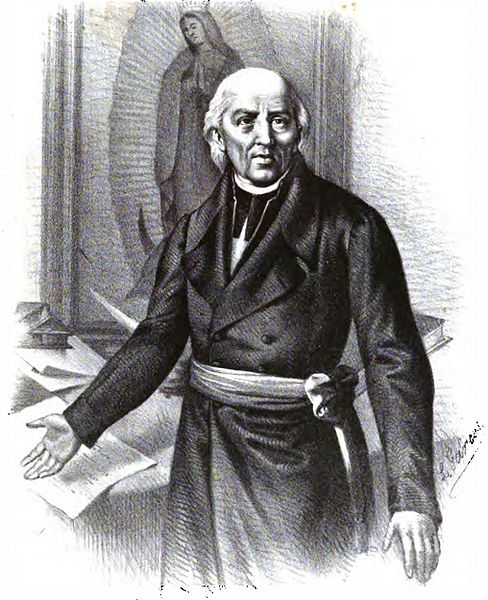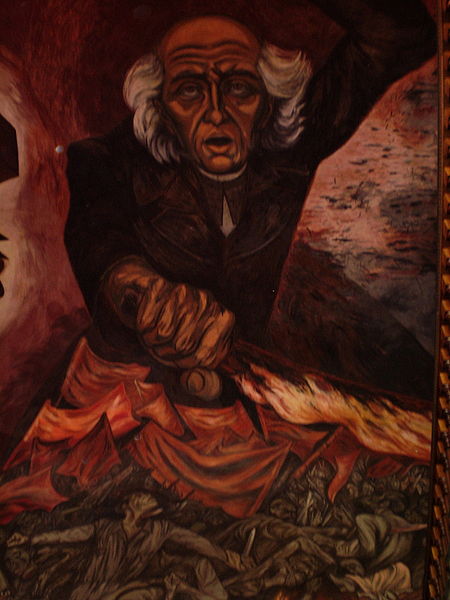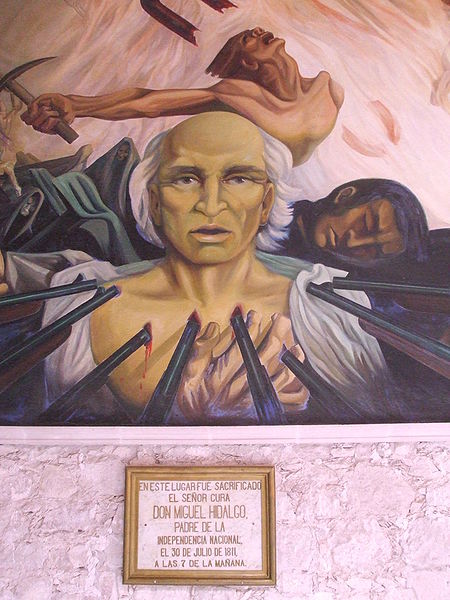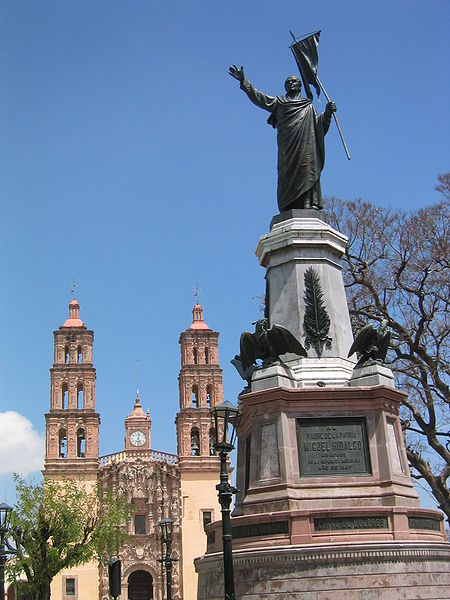<Back to Index>
- Historian Edward Gibbon, 1737
- Painter Nathaniel Dance-Holland, 1735
- General of the Mexican Revolutionary Army Miguel Gregorio Antonio Ignacio Hidalgo y Costilla y Gallaga Mondarte Villaseñor, 1753
PAGE SPONSOR



Miguel Gregorio Antonio Ignacio Hidalgo y Costilla y Gallaga Mondarte Villaseñor (8 May 1753 – 30 July 1811), more commonly known as Miguel Hidalgo y Costilla or simply Miguel Hidalgo, was a Mexican priest and a leader of the Mexican War of Independence.
In 1810 Hidalgo led a group of indigenous and mestizo peasants in a revolt against the dominant peninsulares under the banner of the Virgin of Guadalupe. After clashes with the criollos and Mexican townspeople the group disbanded. Hidalgo was captured on 21 March 1811, and executed on 30 July. Hidalgo's rebellion was the beginning of what would become the Mexican War of Independence. Although he was unsuccessful in his original aim, Hidalgo's efforts were followed by those of José María Morelos and Agustín de Iturbide who brought down the colonial governments of Spain in Mexico. Hidalgo is considered the Father of the Nation of Mexico.
Miguel
Hidalgo
y Costilla was born on 8 May 1753 on the Corralejo
Hacienda in Pénjamo, Guanajuato, to Cristóbal Hidalgo
y Costilla and Ana Maria Gallaga. He was the second of the
couple’s four children. His father was of
middle-class criollo background and served as the hacienda's
administrator. Hidalgo’s full name was
Miguel Gregorio Antonio Ignacio Hidalgo y Costilla y Gallaga Mondarte, with Gregorio Antonio
Ignacio added when he was baptized at the Chapel of Cuitzeo de los
Naranjos. Hidalgo’s mother died when
he was nine. At the
age of twelve, Hidalgo was sent to Valladolid (now Morelia), Michoacan, to
study
at the Colegio de San Francisco Javier with the Jesuits,
along
with his brothers. When the Jesuits were
expelled from Mexico in 1767, he entered the Colegio
de San Nicolas. There he chose to study for
the priesthood. He completed his
preparatory education in 1770. After this, he went to the Royal
and
Pontifical University of Mexico in
Mexico City for further
study, earning his degree in philosophy and theology in 1773. His education for the
priesthood was traditional, with subjects in Latin, rhetoric and logic.
Like
many priests in Mexico, he learned some Indian languages, such as Nahuatl, Otomi and Tarascan.
Along
with these he also studied Italian and French, which were not
commonly studied in Mexico at this time. He was considered cultured
and clever, earning the nickname El Zorro (the fox) from those at his
school. Hidalgo’s
study
of French allowed him to read and study the thought and works of the
Enlightenment that
were current in Europe even though these ideas
were forbidden at the time in Mexico. Hidalgo
was ordained as a priest in 1778 when he was 25 years old. From 1779 to 1792, he
dedicated himself to teaching at San Nicolas as a professor of Latin
grammar and arts, then as a theology professor. Beginning in 1787, he
was named treasurer, vice-rector and secretary, working his way up to
becoming dean of the school in 1790 when he was thirty-nine. While he was dean, Hidalgo
continued to study liberal ideas coming from Europe. This, as well as his
mismanagement of school funds, put him in conflict with his superiors,
leading to his ouster. The Church sent him to work
at the parishes of Colima and San
Felipe
Torres Mochas until
he became the parish priest in Dolores, Guanajuato,
succeeding
his brother Felipe (also a priest), who died in 1802. Although
Hidalgo was educated as a priest in the traditional way, he did not
advocate or live the lifestyle expected of 18th century Mexican
priests. Instead, his studies of Enlightenment era ideas caused him to
challenge traditional political and religious views. He questioned the
absolute authority of the Spanish king and challenged numerous ideas
presented by the Church, including the absolute power of the Pope, the
virgin
birth, and clerical celibacy.
He
enjoyed behavior regarded as outside the parameters of priests,
including dancing and gambling. He openly lived with a woman named
Maria Manuela Herrera, fathering two daughters out
of wedlock with her, and later fathered three other children with a
woman named Josefa Quintana. This
behavior resulted in his appearance before the Court of the Inquisition,
although
the court did not find him guilty. Hidalgo
was
also egalitarian. As parish priest in both San Felipe and Dolores,
he opened his house to Indians and mestizos as
well
as creoles. In 1803,
at the age of fifty, he arrived in Dolores accompanied by his family
that included a younger brother, a cousin, two half sisters, as well as
Maria and their two children. He obtained this parish in
spite of his hearing before the Inquisition, which did not stop his
secular practices. After
Hidalgo settled in Dolores, he turned over most of the clerical duties
to one of his vicars, Father Francisco Iglesias, and devoted himself
almost exclusively to commerce, intellectual pursuits and humanitarian
activity. He spent much of his time
studying literature, scientific works, grape
cultivation, the raising of silkworms. He used the knowledge that
he gained to promote economic activities for the poor and rural people
in his area. He established factories to make bricks and pottery and
trained indigenous people in the making of leather. He also promoted beekeeping. He was interested in
promoting activities of commercial value to use the natural resources
of the area to help the poor. His goal was to make the
Indians and mestizos more self-reliant and less dependent on Spanish
economic policies. However, these activities violated policies designed
to protect Spanish peninsular agriculture and industry, and Hidalgo was
ordered to stop them. These
policies as well as exploitation of the lower castes fostered resentment in
Hidalgo of the Spain-born in Mexico. In addition to the
restriction of economic activities in Mexico, Spanish mercantile
practices would cause misery for the native peoples. A drought in
1807 - 1808 caused a famine in the Dolores area and instead of releasing
grain to market, Spanish merchants decided to hold it in storage,
speculating on higher prices. Hidalgo's
intellectual and political inclinations led him to become involved in
the literary societies or tertulias that were prevalent in
colonial Mexico in the early 19th century. In these circles,
upper-class Mexicans gathered in small groups of family and friends to
drink hot chocolate, eat pastry, and discuss politics and other
matters. Father Hidalgo was fond of them and he, along with others,
found them to be a way to express liberal ideas. Eventually, Hidalgo
would use these even to recruit a number of younger priests into
rebellion. Hidalgo was a prominent
member of such a literary circle in the city of Querétaro, along
with Ignacio
Allende, Mariano
Abasolo, Miguel
Domínguez (alcalde of Querétaro) and
his wife Josefa
Ortiz. This
group was one of many that discussed the Peninsular
War and subsequent
political developments in Spain, especially after Napoleon installed his brother Joseph as king of Spain after
deposing Bourbon king Ferdinand
VII, and the coup
d'état by a group of Peninsulares led by Gabriel
Yermo that removed Viceroy José
de
Iturrigaray in
September 1808. Eventually, this group began a conspiracy to separate the colony from Spain in King
Ferdinand’s name. The conspiracy would have Ferdinand VII be the
monarch of New Spain in separation from Napoleonic Spain. Hidalgo left no treatise or
plan, but it is probable that he favored at least a congress that would
represent all the localities of Mexico and rule with or in Ferdinand
VII’s name. The idea
was to put the plan into action in December 1810. However, the activities of
the Querétaro group were denounced to viceregal authorities,
possibly by a cleric. The group was not yet
militarily ready to begin its movement. After being warned about the betrayal by Josefa Ortiz, Allende and Abasolo wanted to go into
hiding, but Hidalgo disagreed. Fearing
his arrest, Hidalgo commanded his
brother Mauricio, as well as Allende and Abasolo to go with a number of
other armed men to make the sheriff release the inmates there on the
night of 15 Sept. They managed to set eighty free. On the
morning of the 16th, Hidalgo called mass,
which
was attended by about 300, including hacienda owners, local
politicians and Spaniards. There he gave what is now known as the Grito
de
Dolores, calling the people of his
parish to leave their homes and join with him to struggle against the
vice regal government. Hidalgo’s
Grito did not condemn the notion of monarchy or criticize the current
social order in detail, but his opposition to the events in Spain and
the current viceregal government was clearly expressed in his reference
to bad government. The Grito also emphasized loyalty to the Catholic
religion, a sentiment with which both Creoles and Peninsulares could
sympathize; however, the strong anti-Spanish cry of “Death to the
Gachupines” (Gachupines was a name also given to Peninsulares) probably
caused horror among Mexico’s elite.
Hidalgo
was met with an outpouring of support. Intellectuals, liberal priests
and many poor people followed Hidalgo with a great deal of enthusiasm. Hidalgo permitted Indians
and mestizos to join his war in such numbers that the original motives
of the Querétaro group were obscured. Allende was Hidalgo’s
co-conspirator in Querétaro and remained more loyal to the
Querétaro group’s original, more creole objectives. However,
Hidalgo’s actions and the people’s response, meant that he would lead
and not Allende. Allende had acquired military training when Mexico
established a colonial militia; Hidalgo had no military training at all. The people who followed
Hidalgo also had no military training, experience or equipment. Many of
these people were poor who were angry after many years of hunger and
oppression. Consequently, Hidalgo was the leader of an undisciplined
mob. Hidalgo’s
leadership would also give the insurgent movement a supernatural
aspect. Many villagers that joined the insurgent army came to believe
that Ferdinand VII himself commanded their loyalty to Hidalgo and the
monarch was in New Spain personally directing the rebellion against his
own government. They also believed that the king commanded the
extermination of all peninsular Spaniards and the division of their
property among the masses. Historian Eric Van Young believes that such ideas gave the movement supernatural and religious legitimacy that went as
far as messianic expectation. Hidalgo
and Allende left Dolores with about 800 men, half of whom were on
horseback. They marched through the Bajío area,
through Atotonilco, San Miguel el Grande (hoy Allende), Chamucuero,
Celaya, Salamanca, Irapuato and Silao, to Guanajuato. From Guanajuato,
Hidalgo directed his troops to Valladolid, Michoacan. They remained
here for a while and then decided to march towards Mexico City. From Valladolid, they
marched through the State of Mexico, through the cities of Maravatio,
Ixtlahuaca, Toluca coming as close to Mexico City as Monte de las
Cruces, between the Valley
of
Toluca and the Valley
of
Mexico. Just
through sheer numbers, Hidalgo’s army had some early victories. Hidalgo first went through
the economically important and densely populated province of Guanajuato. One of Hidalgo’s first
stops was at the Sanctuary of Nuestra Señora de Guadalupe in
Atotonilco. There, Hidalgo affixed an image of the Virgin to a lance to adopt it as
his banner. He then inscribed the following slogans to his troops’ flags: “Long live religion! Long live
our most Holy Mother of Guadalupe! Long live Ferdinand VII! Long live
America and death to bad government!” For the masses of
insurgents, this Virgin represented an intense and highly localized
religious sensibility. She was invoked to identify allies rather than
to create ideological alliances or a sense of nationalism. The
extent and the intensity of the movement took viceregal authorities by
surprise. San Miguel and Celaya were
captured with little resistance. On 21 September 1810,
Hidalgo was proclaimed general and supreme commander after arriving to
Celaya. At this point, Hidalgo’s army numbered about 50,000. However, because of the
lack of military discipline, the insurgents soon fell into robbing,
looting and ransacking the towns they were capturing. They began to
execute prisoners as well. This caused friction between Allende and Hidalgo as early as the capture of San Miguel in
late September 1810. When a mob ran through this town, Allende tried to
break up the violence by striking at the insurgents with the flat of
his sword. This brought a rebuke from Hidalgo, accusing Allende of
mistreating the people. On 28
September 1810, Hidalgo arrived to the city of Guanajuato. The town’s Spanish and
Creole populations took refuge in the heavily fortified Alhondiga
de
Granaditas granary
defended by Quartermaster Riaños. The insurgents overwhelmed
the defenses in two days and killed an estimated 400 - 600
men, women and children. Allende strongly protested
these events and while Hidalgo agreed that they were heinous, he also
stated that he understood the historical patterns that shaped such
responses. The mass’s violence as well as Hidalgo’s inability or
unwillingness to suppress it caused the creoles and peninsulares to
ally against the insurgents out of fear. This also caused Hidalgo to
lose support from liberal creoles he might have otherwise have had. From
Guanajuato, Hidalgo set off for Valladolid on 10 October 1810
with 15,000 men. When he arrived to Acámbaro,
he
was promoted to generalissimo and given the title of His
Most Serene Highness, with power to legislate. With his new rank he had
a blue uniform with a surgical collar and red lapels meticulously
embroidered with silver and gold. This uniform also included a black baldric that was also embroidered
with gold. There was also a large image of the Virgin of Guadalupe in
gold on his chest. They took
Valladolid with little opposition on 17 October 1810. Here, Hidalgo issued
proclamations against the peninsulares whom he accused of arrogance and
despotism, as well as enslaving those in the Americas for almost
300 years. Hidalgo argued that the objective of the war was “to
send the gachupines back to the motherland” because their greed and
tyranny lead to the temporal and spiritual degradation of the Mexicans. Hidalgo forced the bishop
of Valladolid, Manuel Abad y Queipo to rescind the excommunication order he had circulated
against him on 24 September 1810. Later, the Inquisition
issued an excommunication edict on 13 October 1810 condemning
Miguel Hidalgo as a seditionary, apostate,
and heretic. The
insurgents stayed in the city for some days preparing to march to the
capital of New Spain, Mexico City. The canon of the cathedral went
unarmed to meet Hidalgo and got him to promise that the atrocities of
San Miguel, Celaya and Guanajuato would not be repeated in Valladolid.
The canon was partially effective. Wholesale destruction of the city
was not repeated. However, Hidalgo was angry when he found the
cathedral locked to him. So he jailed all the Spaniards, replaced city
officials with his own and looted the city treasury before marching off
toward Mexico City. On 19 October Hidalgo
left Valladolid for Mexico City after taking 400,000 pesos from
the cathedral to pay expenses. Hidalgo
and his troops left the state of Michoacan and marched through the
towns of Maravatio, Ixtlahuaca, and Toluca before stopping in the
forested mountain area of Monte de las Cruces. Here, insurgent forces
engaged Torcuato Trujillo’s royalist forces. Hidalgo’s troops made
royalist troops retreat but the insurgents suffered heavy casualties
for their efforts, like they did when they engaged trained royalist
soldiers in Guanajuato. After the Battle
of
Monte de las Cruces on
30 October 1810,
Hidalgo still had about
100,000 insurgents and was in a strategic position to attack
Mexico City. Numerically, his forces
outnumbered royalist forces.
The
royalist government in Mexico City, under the leadership of Viceroy Francisco
Venegas prepared
psychological and military defenses. An intensive propaganda campaign
had advertised the insurgent violence in the Bajío area and
stressed the insurgents' threat against social stability. Hidalgo found
the sedentary Indians and castes of the Valley of Mexico as much
opposed to the insurgents as were the creoles and Spaniards. Hidalgo’s
forces came as close as what is now the Cuajimalpa borough of Mexico City. Allende wanted to press
forward and attack the capital, but Hidalgo disagreed. Hidalgo’s reasoning for
this decision is unclear has been debated by historians. One probable factor was
that Hidalgo’s men were undisciplined and unruly and also suffered
heavy losses whenever they encountered trained troops. As the capital
was guarded by some of the best trained soldiers in New Spain, Hidalgo
might have feared a bloodbath. Hidalgo instead decided to
turn away from Mexico City and move to the north through
Toluca
and Ixtlahuaca with a destination of
Guadalajara. After
turning back, insurgents began to desert. By the time he got to Aculco,
just north of Toluca, his army had shrunk to 40,000. There, General Felix
Calleja attacked
Hidalgo’s forces defeating them on 7 November 1810. Allende
decided to take the troops under his command to Guanajuato instead of
Guadalajara. Hidalgo
arrived in Guadalajara on 26 November with over
7,000 badly armed men. He initially occupied the
city with lower-class support because Hidalgo promised to end slavery,
tribute payment and taxes on alcohol and tobacco products. Hidalgo
established an alternative government in Guadalajara with himself at
the head and then appointed two ministers. On
6 December 1810, Hidalgo issued a decree abolishing slavery,
threatening those who did not comply with death. He also abolished
tribute payments that the Indians had to pay to their creole and
peninsular lords. He also ordered the publication of a newspaper called Despertador Americano (American Wake Up Call). He named Pascacio Ortiz de
Letona as representative of the insurgent government and sent him to
the United States to seek support there. However, this ambassador was
apprehended by the Spanish army while in route to Philadelphia and
executed. During
this time, insurgent violence mounted in Guadalajara. Citizens loyal to
the viceregal government were seized and executed. While indiscriminate
looting was avoided, the insurgents targeted the property of creoles
and Spaniards, regardless of political affiliation. In the meantime, the
royalist army has retaken Guanajuato, forcing Allende to flee to
Guadalajara. After he arrived to the
city, Allende again objected to Hidalgo concerning the insurgent
violence. However, Hidalgo knew the royalist army was on its way to
Guadalajara and wanted to stay on good terms with his own army. After
Guanajuato had been retaken by royalist forces, the bishop there
excommunicated Hidalgo and those under him, declaring them to be
heretics, perjurers and blasphemers on 24 December 1810. The
Inquisition pronounced
an edict against him containing a large number of charges including
denying that God punishes sins in this world, doubting the authenticity
of the Bible, denouncing the popes and Church government, that Jews
should not have to convert to Christianity, denying the perpetual
virginity of Mary, preaching that there was no hell and adopting
Lutheran doctrine with regards to the Eucharist. Fearful of losing
support of his army because of these decrees, Hidalgo responded that he
had never departed from Church doctrine in the slightest degree. Royalist
forces marched to Guadalajara, arriving in January 1811 with nearly
6,000 men. Allende and Abasolo wanted
to concentrate their forces in the city and plan an escape route should
they be defeated, but Hidalgo rejected this. Their second choice then
was to make a stand at the Calderon
Bridge (Puente
de Calderon) just outside the city. Hidalgo had between
80,000 and 100,000 men and 95 cannons, but the better
trained royalists won, decimating the insurgent army, forcing Hidalgo
to flee towards Aguascalientes. At Hacienda de Pabellon, on
25 January 1811, near Aguascalientes,
Allende
and other insurgent leaders took military command away from
Hidalgo, blaming him for their defeats. Hidalgo remained as head
politically but with military command going to Allende. What was
left of the insurgent Army of the Americas moved north towards Zacatecas and Saltillo with the goal of making
connections with those in the United States for support. Hidalgo made it to
Saltillo, where he publicly resigned his military post and rejected a
pardon offered by General José de la Cruz in the name of Venegas in return for Hidalgo’s surrender. A short time later, they
were betrayed and captured by royalist Ignacio
Elizondo at the Wells
of
Baján (Norias de Baján)
on
21 March 1811 and taken to the city of Chihuahua. Hidalgo
was turned over to the bishop of Durango,
Francisco
Gabriel de Olivares, for an official defrocking and excommunication on
27 July 1811. He was then found guilty of treason by a
military court and executed by firing squad on 30 July at 7
in the morning. Before his execution, he
thanked his jailers, Private Soldiers Ortega and Melchor, in letters
for their humane treatment. At his execution, Hidalgo placed his right
hand over his heart to show the rifleman where they should aim. He also
refused the use of a blindfold. His body, along with the
bodies of Allende, Aldama and José
Mariano
Jiménez were
decapitated and the heads were put on display on the four corners of the Alhondiga
de
Granaditas in Guanajuato. The heads remained there
for ten years until the end of the Mexican
War
of Independence to
serve as a warning to other insurgents. Hidalgo’s headless body was
first displayed outside the prison but then buried in the Church
of
St Francis in Chihuahua.
Those
remains would later be transferred in 1824 to Mexico City. Hidalgo’s
death resulted in a political vacuum on the insurgent side until 1812.
The royalist military commander, General Felix Calleja, continued to
pursue rebel troops. Insurgent fighting evolved
into guerrilla warfare, and eventually the next
major insurgent leader, Jose
Maria
Morelos y Pavon, who had led rebel movements with Hidalgo,
became head of the insurgents. Hidalgo
is hailed as the ‘‘Father of the Nation’’ even though it was Agustin
de
Iturbide and not
Hidalgo who achieved Mexican Independence in 1821. Shortly after gaining
independence, the day to celebrate it varied between 16 September, the
day of Hidalgo’s Grito and 27 September, the day Iturbide rode into
Mexico City to end the war. Later, political movements
would favor the more liberal Hidalgo over the conservative Iturbide, so
that eventually 16 September 1810 became the officially
recognized day of Mexican independence. The reason for this is that
Hidalgo is considered to be “precursor and creator of the rest of the
heroes of the (Mexican War of) Independence.” Hidalgo has become an icon
for Mexicans who resist tyranny in the country. Diego Rivera painted
Hidalgo’s image in half a dozen murals. Jose
Clemente
Orozco depicted
him with a flaming torch of liberty and considered the painting among
his best work. David
Alfaro
Siqueiros was
commissioned by San Nicolas University in Morelia to paint a mural for
a celebration commemorating the 200th anniversary of Hidalgo's birth. The town of his parish was
renamed Dolores Hidalgo in his honor and the state of Hidalgo was created in 1869. Every
year
on the night of 15–16 September, the president of Mexico re-enacts
the Grito from the balcony of the National
Palace. This scene is repeated by the heads of cities and towns all
over Mexico. The
remains of Miguel Hidalgo y Costilla lie in the column of the Angel
of
Independence in
Mexico City. Next to it is a lamp lit to represent the sacrifice of
those who gave their lives for Mexican Independence.
